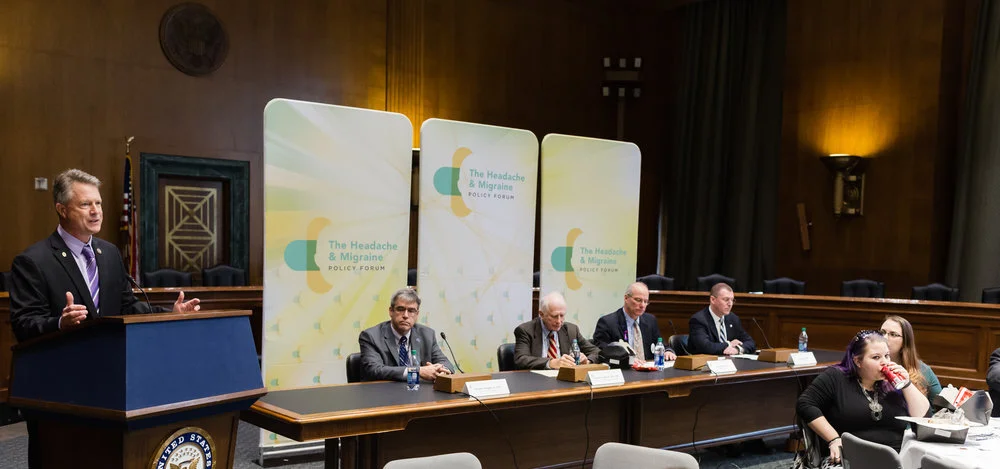“It was so bad. It just wouldn’t quit.” Sara, a new patient, was sitting in my office describing a migraine attack that had led to a recent hospitalization. Except it wasn’t exactly the migraine that led to hospitalization. It was, I found out, an attempted suicide, prompted by the relentless impact of chronic migraine.
Can ICER Fix What's Broken?
Health Plan Barriers & Migraine Are a Losing Combination
Introducing: Migraine at Work
Migraine at Work, a project of the Headache and Migraine Policy Forum, has launched a new website to support employers and employees with the tools they need to build happier, healthier and more productive workplaces. Whether you’re looking to initiate a positive conversation with your employer or simply learn about effective strategies for managing your disease at work, this website is a great place to start.
Amgen is a founding sponsor of Migraine at Work.
AMA calls pain task force recommendations a road map for future policy
New "Fast Facts" Scrutinizes ICER
Policymakers, providers and patients all feel the impact of The Institute for Clinical and Economic Review, whose ubiquitous cost-effectiveness reports can determine patients’ access to medicine. But could these stakeholders and the public find real answers to basic questions – like “What is ICER?” and “Who controls ICER?”
Non-Medical Switching Hurts Patients
Policy Event Spotlights Migraine & Disability Issues
HMPF Capitol Hill Policy Forum 2019
Non-Medical Switching of Neurotoxins
The Migraine Thief
For years, migraine disease stole time, personal goals, career plans and even Jaime Sanders’ ideal of motherhood. But her condition no longer manages her, she manages it—and she advocates so migraine disease patients can access the innovative medications they need.
Which Migraine Patients Should Get CGRP Drugs?
Amplifying the Migraine Community's Voice in ICER's Value Assessment Process
Speeding Progress in Migraine Requires Unraveling Sex Differences
To decrease the substantial health and economic burden of migraine on individuals and society, researchers need to examine and address how the disease differs between women and men, according to a report from the Society for Women’s Health Research published in the August issue of the Journal of Women’s Health.
Patients' Fight for Access
Migraine patients deserve access to innovative therapies. Ready to get involved? Watch their story and join the fight for access now.
Veterans Issues Dominate Headache Policy Event
from Institute for Patient Access
Add migraine to the long list of battles faced by veterans of the United States Armed Services.
In a Tuesday policy panel sponsored by The Headache and Migraine Policy Forum, experts from across the health care and veterans support spectrum weighed in on how migraine and headache disorders impact veterans – and whether these women and men can access the treatment they need.
The conversation highlighted several issues:
Personalized Treatment
“If you’ve seen one patient, you’ve seen one patient,” explained James R. Couch, Jr., MD, PhD, the acting medical director for the Comprehensive Inpatient Integrated Rehabilitation Program at Oklahoma City’s VA Medical Center. “Don’t try to mash them all together and say ‘this should work for everybody.’”
Iraq and Afghanistan’s Impact
“These soliders were changed while they were protecting us and our freedoms,” noted Alan Finkel, MD, who treats active-duty soliders at Fort Bragg. Calling affected veterans, “armies of one,” Dr. Finkel alluded to migraine comorbidities such as severe depression, PTSD, sleep disturbances and anxiety.
Access
“I am amazed on a daily basis at the breadth of the services that are available and can be made availalbe to our veterans,” noted Donald S. Higgins, MD, the national program director for neurology at the Veterans Health Administration. Dr. Higgins noted that life-changing, cutting-edge therapies are available at the VA system, as are telehealth and teleneurology applications.
Panelists agreed on the need for more trained headache specialists. “We used to get no lectures on headache in medical school,” Dr. James Couch noted, adding, “Now we get two to three or more. Gradually, we’re improving. This should continue.”
Stigma
Christopher Meek, co-founder and CEO of SoldierStrong Access, described the impact of stigma on veterans and active duty servicemembers. The “warrior effect” can keep veterans from acknowledging their disorder and seeking treatment. Having migraine or another headache disorder “makes them feel like a failure,” Meeks explained, “It takes them to a dark place.”
David Charles, MD, neurologist and chairman of the Alliance for Patient Access, moderated the panel.
The Headache & Migraine Policy Forum advances public policies that promote accelerated innovation and improved treatments for headache and migraine sufferers. Its policy forum coincided with more than 225 Capitol Hill meetings as part of the annual Headache on the Hill advocacy day, sponsored by the Alliance for Headache Disorders Advocacy.
Headache on the Hill brings health care professionals, migraine advocates and patients to Capitol Hill to raise awareness about the impact of headache and migraine disorders and to seek increased research funding. This marked the event’s 11th year.
HMPF Capitol Hill Policy Forum 2018
Who Are Headache Disorders & Migraine Hurting?
Who feels the impact of headache disorders and migraine? More people than you may think, according to a new video from The Headache & Migraine Policy Forum.
Collectively, 39 million men, women and children in the United States and more than 1 billion people worldwide experience migraine, the third most prevalent illness in the world. As the video explains, migraine has emerged as a common problem for veterans, particularly those who have been deployed or have suffered a traumatic brain injury. While some headache disorders disproportionately affect women, others are genetic, afflicting a family one generation after another. Those who have experienced an injury or stroke are another affected group.
Read more at Institute for Patient Access.
Visible Burden, Invisible Disease
What’s worse than battling a debilitating, painful and costly disease? Having to convince people that it’s real.
Yet that’s just what many of the 40 million Americans with migraine and headache disorders must do. In a panel discussion during the recent National Summit on Balanced Pain Management, advocates pinpointed several common myths– and described how stigma compounds the pain of headache disorders.
Read more at Institute for Patient Access.
Wide Variation in Triptan Coverage Across Commercial and Government Health Plans
Insurance coverage of triptan medications varied widely between health plans and imposed quantity limits, step therapy, prior authorization requirements, and multiple co-payment tiers, according to findings published in the July 9 online issue of Headache.
"The complexity and convolution of finding and understanding much of the insurance information was a bit dismaying," first author Mia T. Minen, MD, chief of headache research in the division of headache medicine at New York University Langone Medical Center, told Neurology Today in an interview.
Dr. Minen noted that given the overuse of opioids in the US, "key players might realize that they should work on improving access to non-opioid therapies… In addition, with the increasing likelihood of more expensive migraine medications coming to the market, such as the calcitonin gene-related peptide antagonists, insurance companies might decide to lower the barriers of these cheaper alternatives," she said.
Read more at Neurology Today.






